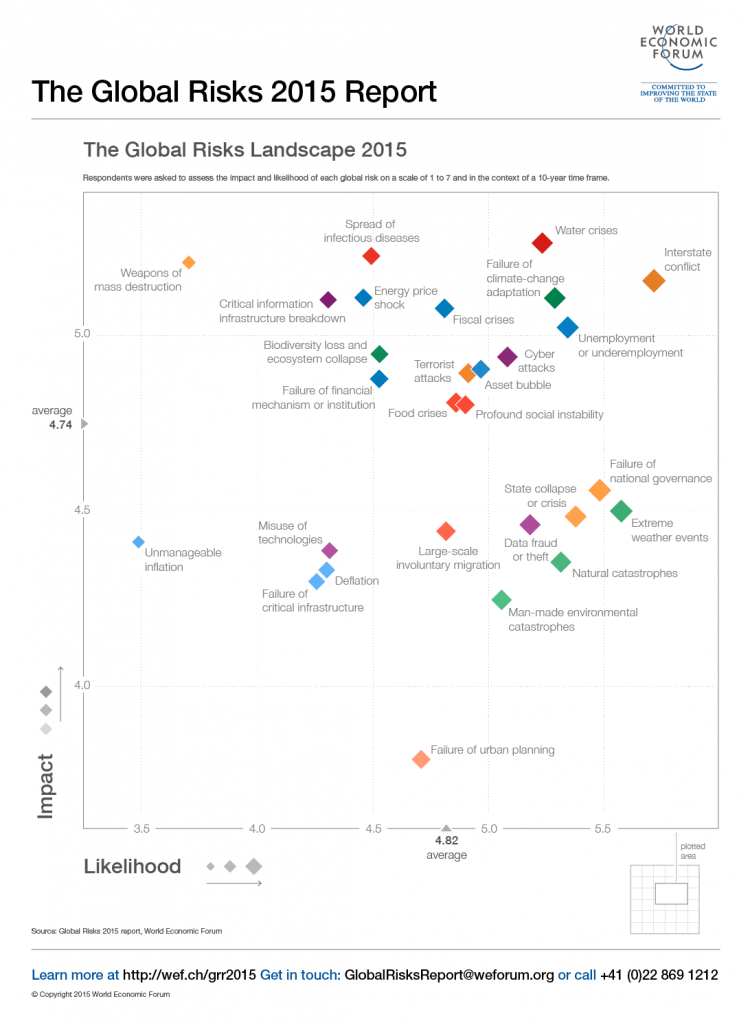The 2015 World Economic Forum in Davos identified water crises – flood, drought, and pollution – as the risk with the largest expected impact over the next 10 years in its 2015 Global Risks report. The report posits that over 50 percent of the planet’s water is already diverted for human use, and that number is rising. Competition for scarce, clean water creates conflicts across the world, in cities from Durban to Los Angeles to Mexico City. Effective water management to confront clean water scarcity is a major concern for most cities.
The Blues: What is driving water risk?
According to The Nature Conservancy’s (TNC) Water Blueprint, the watersheds servicing the world’s cities cover 12 percent of the planet’s land area, even though cities cover only 1 percent. Cities’ large water footprint is a symptom of expanding agriculture and land-use as well as distribution losses in water systems. TNC estimates that the 100 largest cities in the world transfer 43 percent of their water—3.2 million cubic meters—a distance of more than 5,700 kilometers every day in artificial channels.
Lower-income cities often cannot afford the large infrastructure for inter-basin water transfers, and must rely more heavily on local, oft-polluted, water sources. For instance, in Africa where average annual growth in cities and towns is the fastest in the world at an average of 5 percent, 358 million people lack access to safe drinking water.
From our partners:
The costs of these risks are high in human and financial terms. Water-related illness is the leading cause of under-five mortality—more than HIV AIDS, malaria, and measles combined. Sub-Saharan Africa loses an estimated 4.3 percent of its GDP each year due to lack of adequate water supply and sanitation. The African Development Bank estimates global water supply system losses at 20 percent, and at 35 percent for African cities. The World Bank estimates that poor sanitation and water supply result in economic losses of US$260 billion annually in developing countries, or 1.5 percent of their GDP. Cities have a number of options to confront the inefficiencies of their water systems and reduce their exposure to the types of risks that threaten cities over the next decade.
In the Black
New York City worked with Veolia, a French water management consultant and 100 Resilient Cities platform partner, to address water inefficiencies that were leaking 36 million gallons a day. By optimizing quality of service and re-training the existing workforce, they reduced users’ bills while saving the city about $100 million. Similar engagements with other major U.S. and European cities have also had a large impact, cutting losses and generating huge savings for utility operators in Pittsburg and St. Louis, for example, and improving the quality of service people enjoy.
Green Investments
Supporting healthy watersheds is another low-cost—or event revenue generating—option for cities with water problems. ’Green infrastructure’ investments are one approach that often yields multiple benefits and builds city resilience. The Nature Conservancy, also a 100RC platform partner, estimated the benefits from five conservation strategies that are within reach of most municipalities: land protection, reforestation, riparian restoration, agricultural best management practices, and forest thinning. Applied strategically to reduce nutrient flows and sedimentation in water sources, these methods could save hundreds of millions of dollars in operations costs for city water supply systems.
“The risk of water – flood, scarcity, and pollution – is especially acute in cities where more people are competing for ever-more contested resources, and poorer cities feel the effects of these challenges much more sharply.”
However, cities that undertake shrewd water management and efficient, low-cost interventions stand to not only address their water challenges, but save money and improve the life of their inhabitants at the same time.
This feature is adopted from 100 Resilient Cities















